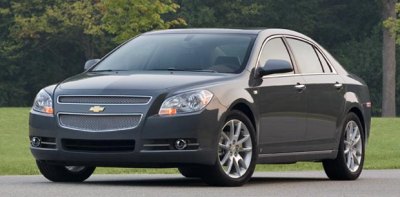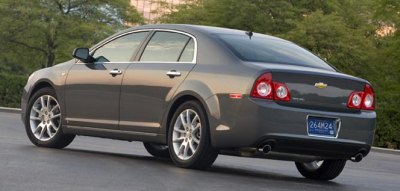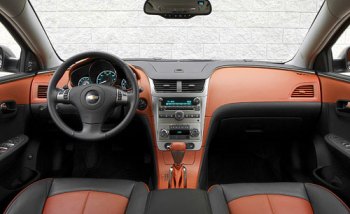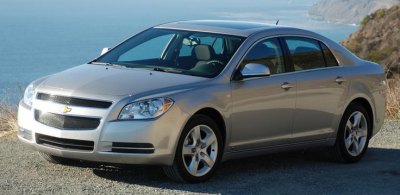|

|
Another world-class GM product since
Saturn Aura
|
The
bloodline first: Chevrolet Malibu is one of the derivatives of General
Motor's Epsilon II platform. Its sister cars include Saturn Aura,
Pontiac G6 (based on Epsilon I) and the next generation Opel Vectra and
hopefully next Saab 9-3. It is especially closest to Saturn Aura,
sharing most of the latter's good ingredients, such as the Holden
3.6-liter DOHC V6, the Opel 2.4-liter DOHC balance-shafted inline-4,
the GM-Ford paddle-shift 6-speed automatic transmission and the
up-to-date suspensions consisting of aluminum MacPherson struts up
front and multi-link at the rear. These sound very "un-American", don't
they ? After criticizing American cars for a decade, I am finally
pleased to see they are going up to international standards again !
For sure, the new Malibu has to face some stiff competitions from the
Japanese - Toyota Camry, Honda Accord and Nissan Altima. They are
either recently renewed or still very young in their life cycle. To
beat the Japanese in the US market has always been difficult - not even
Volkswagen Passat can do that. However, Saturn Aura has shown that this
task is not impossible, because it beat Camry in NACOTY contest last
year. Can its Chevrolet sister repeat the same success against the new
Honda Accord ? We shall see soon.

|
The influence of Volkswagen design is
apparent in many places
|
One
thing we can answer right now is, the Chevrolet looks definitely
handsomer than Honda. Surprisingly, this American sedan looks totally
irrelevant to traditional American designs but almost like a classy
European car. Can you see the Volkswagen Phaeton-style C-pillars ? or
the Passat-style tail ? It is elegant yet restrained. The only American
feature is the prominent double-layer grille which looks surprisingly
good. Still want that ugly Accord or dull Camry ? Don't joke !
The cabin also surprises. American cars used to look good outside but
terribly low-rent inside. This is no longer true to the latest GM cars.
Thanks to the order by Bob Lutz, extra money and effort were spent to
improve the interior of Malibu, resulting in a stylish and pretty
high-quality environment. There are soft-touch plastics on the dash,
chromed bezels and illuminated gauges. Yes, it is not a European car,
so you will find hard plastics at the door panels and the back of the
front seats, but all plastic parts are tightly assembled. The overall
build quality is better than Camry and Altima, only slightly behind the
new Honda.
Seating comfort up front is good. On the contrary, the rear seats are
short of shoulder room and legroom compare with rivals. The former is
not a surprised, because the Malibu is narrow and its prominent
shoulder line eats into cabin width. In contrast, the short of rear
legroom is quite mysterious, because this car has the longest wheelbase
in class (2852 mm). Passengers over 6-ft 2 will find they knees entered
the concave area of the front seatbacks, which means they cannot rest
their legs naturally apart.

|
This is the nicest interior ever
produced by Chevrolet
|
Epsilon
II has always been a refined chassis. However, compare with Saturn
Aura, Chevrolet Malibu paid even more attention to reduce NVH. It
employs laminated glass, quiet steel, composite wheel well liners,
improved door seals and spray-on sound-absorbing materials in the
engine compartment. Moreover, the suspension tuning is softer than
Saturn Aura to favour the majority of family car buyers. As a result,
the Malibu is remarkably refined on the road. Both wind and road noise
suppression are excellent. The ride is smooth and quiet without
damaging handling. Even the slightly coarse Ecotec 4-pot engine sounds
sweeter after the acoustic tuning.
In the dynamic side, the 2.4-liter four-pot engine with 169 horsepower
and 160 lb-ft of torque is not the most inspiring choice when mated
with an outdated 4-speed automatic gearbox. Luckily, both are as
refined as the Japanese offerings. Anyway, once the 4-speed auto phase
out of production, it will be replaced with an excellent 6-speed
automatic. For now, the 6-speeder serves exclusively the 3.6-liter V6,
which pumps out 252 horsepower and 251 lb-ft of torque. In isolation,
this engine is not yet on a par with Japanese V6s no matter in
horsepower or refinement. However, the Malibu V6 compensates with 6
gear ratios and the ability of fingertip shifting via the steering
wheel-mounted paddles. It still won't match its Japanese rivals for
performance, primarily because it is heavier, but the performance is
plenty enough and is enjoyable to exploit.

|
Superior ride comfort and
well-balanced handling highlights its dynamic package, although
powertrain is neither disgraceful.
|
Perhaps
the best thing of Malibu is its good balance between ride and handling.
This car offers ride composure superior to Accord and Altima, but
without soft to the extent of Camry on standard suspension setup.
Unlike latter, it does not float or bounce over low-speed undulation.
The result is the calmest and the most comfortable ride among its
rivals. While it doesn't inspire drivers as much as Saturn Aura (or
undoubtedly the European Ford Mondeo), it still displays good body
control in corners and good high-speed stability.
If there is anything wanting, it must be the steering. The V6 model
employs conventional hydraulic power steering, which is fine in
weighting and accuracy while communication is reasonable. In contrast,
the 4-cylinder model (which is expected to consist of 70 percent of
sales) employ a cheaper electric power steering. Its assistance is
already tuned to be more consistent than previous systems used by GM,
but it still isn't the most communicative electric steering on the
market. There is still some way to go before it can really replace
hydraulic steering.
However, even the steering problem or the short of rear cabin room
could not be
considered
as serious flaws. Very rare to an American car, Malibu is
well rounded in all areas car buyers care for. Most important, it no
longer feels cheap like traditional American cars. In fact, it feels
quite upmarket. If GM continue producing cars as good, it won't be
difficult to take back the World No. 1 title from Toyota - although I
doubt that. |